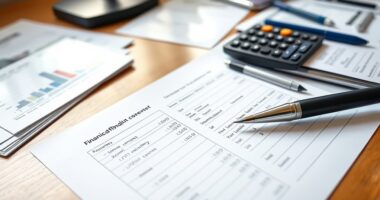To build an emergency fund as a single-income household, focus on prioritizing low-risk, highly liquid accounts like high-yield savings and money market funds. Pay down high-interest debt first to free up more money for savings. Set clear goals for your safety net to cover three to six months of living expenses. Consistently contribute small, manageable amounts, and avoid risky investments. Keep your emergency fund accessible, and learn strategies that maximize your financial security. If you keep exploring, you’ll discover key steps to strengthen your safety net even more.
Key Takeaways
- Prioritize high-yield savings accounts or money market funds for quick, low-risk access to emergency cash.
- Eliminate high-interest debt first to free up more funds for building your safety net.
- Aim to save 3-6 months of living expenses as your emergency fund benchmark.
- Incorporate disciplined, regular contributions into your budget to steadily grow your emergency savings.
- Focus on liquidity and security over high returns to ensure funds are accessible when needed.

An emergency fund is a essential financial safety net that can protect you from unexpected expenses and income disruptions. As someone managing a single income, you know how critical it is to have a safety buffer in place. But building this fund requires more than just saving money; it involves smart planning and strategic thinking. Your first step should be understanding how your overall financial picture fits together, especially focusing on investment strategies and debt management. These elements influence how quickly and comfortably you can set aside funds for emergencies.
Building an emergency fund requires strategic planning, balancing investments, and managing debt for financial security.
When it comes to investment strategies, your goal is to balance growth with accessibility. While investments like stocks or retirement accounts can generate long-term wealth, they aren’t suitable for emergency funds because they aren’t immediately accessible without penalties or loss of value. Instead, look for low-risk, liquid assets such as high-yield savings accounts or money market funds. These options offer quick access when you need cash urgently, without risking your principal. Incorporating these into your savings plan ensures your emergency fund remains reliable while still earning some interest. Keep in mind that your investment approach should prioritize safety and liquidity over high returns, especially since the purpose of this fund is to serve as a quick financial cushion.
Debt management plays a fundamental role in how much you can allocate toward your emergency fund. If you’re carrying high-interest debt, like credit card balances or payday loans, it’s often smarter to focus on paying down those debts first. High-interest debt can quickly erode your savings potential because the interest costs can overshadow the benefits of your emergency fund. Once you’ve reduced or eliminated costly debt, you free up more money that can be directed toward building your safety net. Managing your debt effectively also improves your overall financial stability, making it easier to save consistently. Establishing a debt repayment plan alongside your savings goals helps you prioritize and stay on track, ensuring that you’re not caught in a cycle of debt that hampers your efforts to create an emergency fund. Additionally, understanding liquidity and accessibility in your savings options helps you choose the best assets for emergency readiness.
Ultimately, creating a robust emergency fund as a single-income household involves thoughtful planning around investment strategies and debt management. By choosing the right types of savings accounts and reducing high-interest liabilities, you set yourself up for financial resilience. These steps give you peace of mind knowing you’re prepared for surprises, whether it’s a medical emergency, job loss, or unexpected home repairs. Building this safety net takes discipline, but the security it provides is well worth the effort, allowing you to face uncertainties with confidence and control.
Frequently Asked Questions
How Should I Prioritize My Emergency Fund if I Have High Debt?
If you have high debt, prioritize debt repayment first to reduce interest costs and improve financial stability. Once you’ve made steady progress, shift your savings strategy to build an emergency fund, aiming for at least three to six months of living expenses. This balance guarantees you’re reducing debt effectively while still protecting yourself against unexpected expenses. Focus on consistent payments and gradually increase your savings for both goals over time.
What’s the Ideal Timeline to Build an Emergency Fund?
You can build your emergency fund in about three to six months, but who needs deadlines, right? Ironically, the real milestone is when your savings cover three to six months of expenses. To get there, prioritize budget adjustments, cut unnecessary costs, and stay consistent. This timeline keeps you flexible, letting your financial milestones guide you, even if life throws some unexpected expenses your way.
Can I Use Retirement Savings as an Emergency Fund?
You shouldn’t use your retirement account as emergency savings because it’s meant for long-term growth, and withdrawals may face taxes and penalties. Instead, keep an emergency fund separate, ideally in a high-yield savings account, so you have quick access when needed. Using retirement savings can jeopardize your future financial security, so prioritize building a dedicated emergency fund to cover unexpected expenses without risking your retirement goals.
How Do I Adjust My Emergency Fund During Income Fluctuations?
Like a captain steering through changing tides, you should adjust your emergency fund during income fluctuations by reassessing your savings needs. If your income dips, increase your savings efforts to build a buffer, and if it rises, consider bolstering your fund further. Prioritize maintaining income stability by making timely savings adjustments. This proactive approach guarantees you’re prepared, regardless of financial currents, keeping your safety net strong and reliable.
What Are the Best Investment Options for Emergency Fund Growth?
You should focus on safe, liquid investment strategies to grow your emergency fund. Consider high-yield savings accounts, which offer better interest rates while keeping your money accessible. Certificates of deposit (CDs) are also good for earning more with a fixed term, but guarantee they match your liquidity needs. Avoid risky investments; your priority is preserving capital and ensuring quick access in emergencies.
Conclusion
So, now that you’re armed with your emergency fund planner, remember: life loves throwing curveballs, especially at single-income households. Sure, saving enough might seem like a formidable quest, but hey, who needs a financial safety net when you could just pray for the best? Just kidding! Take action today, build that fund, and sleep soundly knowing you’ve got a backup plan—because relying on luck isn’t exactly a solid strategy.









